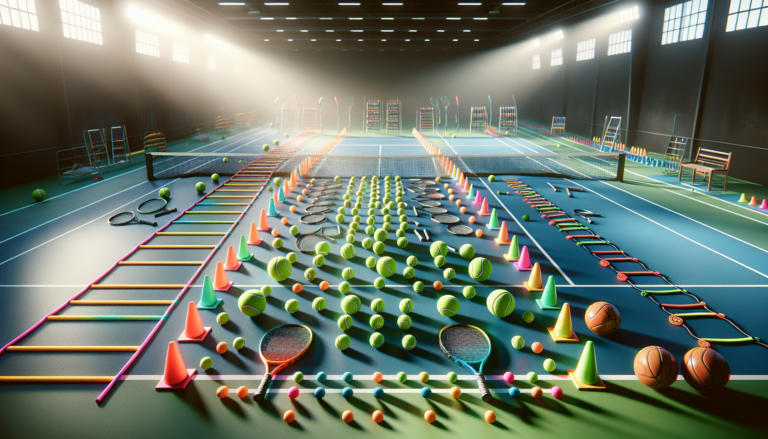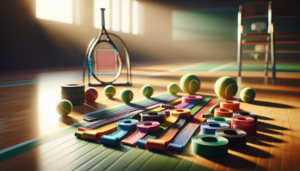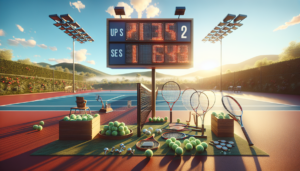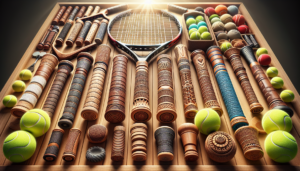Introduction to Tennis Drills
Tennis drills are essential for players of all levels looking to improve their game. Consistently practicing specific exercises can help develop and refine the skills needed to excel on the court. From groundstrokes to serves, volleying to footwork, incorporating targeted drills into your training routine is key to becoming a well-rounded player.
Why Tennis Drills are Important
Tennis drills serve several important purposes for players seeking to elevate their performance:
- Skill Development: Drills allow you to isolate and focus on specific areas of your game, such as forehand and backhand technique, serving accuracy, or net play.
- Muscle Memory: Repetition through drills helps ingrain proper form and technique into your muscle memory, making the correct motions more automatic during matches.
- Improved Consistency: Regularly practicing drills enhances your ability to execute shots consistently, even under pressure.
How to Incorporate Drills into Your Training
To get the most out of tennis drills, it’s important to approach them strategically:
- Set Goals: Identify the specific skills you want to improve and select drills that target those areas.
- Start Slowly: Focus on proper form and technique before increasing speed or difficulty. Rushing can lead to developing bad habits.
- Introduce Variety: Incorporate a range of drills to keep your training engaging and work on different aspects of your game.
- Seek Feedback: Work with a coach or experienced player who can provide guidance and help you refine your technique.
Groundstroke Drills
Mastering consistent, powerful groundstrokes is essential for any tennis player. These drills will help you hone your forehand and backhand technique from the baseline.
Forehand and Backhand Groundstrokes
One of the most basic yet critical tennis drills is hitting continuous forehand and backhand groundstrokes from the baseline. This exercise helps groove your swing path, improve consistency, and build stamina.
To perform this drill:
- Start at the baseline, with a partner or ball machine on the other side of the net.
- Hit a series of forehands, focusing on proper grip, stance, and swing technique.
- After a set number of forehands, switch to backhands.
- Continue alternating between forehands and backhands for the desired number of repetitions or time.
As you become more comfortable, increase the tempo or add movement by hitting shots while side-shuffling along the baseline.
Crosscourt and Down-the-Line Shots
Varying the direction and angle of your groundstrokes is crucial for keeping opponents off balance and opening up the court. This drill emphasizes hitting both crosscourt and down-the-line shots with precision.
| Steps | Instructions |
|---|---|
| 1 | Begin in the center of the baseline, with a partner or ball machine sending shots from the opposite baseline. |
| 2 | Hit a crosscourt forehand, aiming for the intersection of the service line and singles sideline. |
| 3 | Recover back to the center and prepare for the next ball. |
| 4 | Hit a down-the-line forehand, aiming inside the singles sideline. |
| 5 | Continue alternating between crosscourt and down-the-line shots, maintaining accuracy and consistency. |
Progress to hitting a combination of forehands and backhands, crosscourt and down-the-line, as you advance.
Serve and Volley Drills
While the serve and volley style has become less common in the modern game, it remains an effective tactic, especially on faster court surfaces. These drills will help you improve your serving accuracy and volleying skills.
Improving Your Serve
Developing a strong, reliable serve is a crucial component of any player’s arsenal. This drill focuses on serving accuracy and consistency.
- Begin on the baseline, with a full basket of balls.
- Choose a specific serve target, such as deep into the service box or out wide near the sideline.
- Serve a ball, aiming for your chosen target. Assess your accuracy.
- Continue serving, maintaining a consistent toss and swing motion.
- After hitting all the balls, evaluate your overall accuracy and identify areas for improvement.
To increase difficulty, add movement by serving and then immediately moving forward as if approaching the net.
Mastering the Volley
Being comfortable at the net is essential for any serve and volley player. This drill helps improve your volleying technique and reaction time.
| Steps | Instructions |
|---|---|
| 1 | Stand just behind the service line, with a partner positioned on the baseline. |
| 2 | Have your partner hit a series of shots directly at you. |
| 3 | Volley each ball back, focusing on crisp contact and maintaining a strong, stable wrist. |
| 4 | Adjust your volleys based on the incoming shot – hit higher volleys on deep shots and lower, angled volleys on shots below the net. |
As you progress, have your partner vary the placement and speed of their shots, moving you side to side along the service line.
Footwork and Agility Drills
Efficient movement and agility are key in tennis, allowing you to set up for shots and recover defensively. Incorporate these footwork drills to improve your speed and court coverage.
Ladder Drills for Quick Feet
Agility ladders are an excellent tool for developing quick, precise footwork. These drills challenge your coordination and speed.
Some popular tennis ladder drills include:
- Forward run-through: Run through the ladder, placing one foot in each square.
- Lateral shuffle: Moving laterally, shuffle through the ladder, maintaining a low center of gravity.
- In-and-out steps: Facing the ladder sideways, step in and out of each square with both feet.
- Hopscotch: Jump through the ladder, landing with either one or both feet in each square according to a set pattern.
Perform each drill multiple times, focusing on speed and precision of movement. Incorporating ladder drills into your regular training helps improve your on-court footwork.
Cone Drills for Directional Movement
Setting up cones in specific patterns simulates the varied movement required during tennis matches. These drills enhance your ability to change direction quickly and efficiently.
One effective cone drill is the “V” drill:
- Set up five cones in a V shape, with the point of the V on the baseline and the two ends near the service line.
- Start at the point of the V. Sprint to one end cone and touch it with your racket.
- Quickly pivot and sprint to the other end cone, again touching it with your racket.
- Sprint back to the starting cone. That completes one repetition.
- Perform multiple reps, maintaining quick, controlled movements.
Other effective cone drills include setting up cones in a square or diagonal pattern, with each drill emphasizing different directional movements commonly used in tennis.
Hand-Eye Coordination Drills
Sharp hand-eye coordination is essential for making clean contact with the ball and reacting quickly to your opponent’s shots. These drills will help refine that crucial skill.
Ball Toss and Catch
A simple yet effective way to improve hand-eye coordination is through ball toss and catch drills. These exercises force you to track the ball closely and make precise movements.
Start with a basic toss and catch:
- Using a tennis ball, toss the ball straight up above your head.
- Catch the ball with your dominant hand.
- Repeat, tossing the ball higher each time to increase difficulty.
- Progress to catching with your non-dominant hand or alternating hands.
Advance to tossing and catching while moving, simulating the dynamic nature of tennis.
Reaction Time Drills
Improving your reaction time allows you to respond more effectively to your opponent’s shots. This drill challenges you to quickly process and respond to visual cues.
To perform a reaction time drill:
| Steps | Instructions |
|---|---|
| 1 | Stand facing a partner, with both of you on the baseline. |
| 2 | Have your partner hold two balls, one in each hand, behind their back. |
| 3 | Your partner reveals one ball. Quickly identify which hand is holding the ball and shout out “left” or “right.” |
| 4 | Your partner then tosses the ball to you. Catch it and toss it back. |
| 5 | Repeat for a set number of repetitions, with your partner mixing up which hand reveals the ball. |
To increase the challenge, have your partner fake a toss or vary the speed and height of their tosses.
Mini-Games and Simulated Match Play
While drills are important, it’s also beneficial to incorporate game-like situations into your practice. This allows you to apply your skills in a more realistic, high-pressure setting.
Simulating Real Match Conditions
Playing out points in a structured practice setting helps you prepare for the challenges of actual matches. Set up game-like situations to test your skills.
For example, play “king of the court”:
- Have multiple players line up behind the baseline, with one player starting as the “king” on the opposite side.
- The first player in line feeds a ball to the king and plays out the point.
- If the challenger wins, they become the new king. If the king wins, the challenger goes to the back of the line.
- Each challenger plays one point against the king before rotating out.
- Play until a set number of total points are completed.
This drill forces you to play at a high level consistently, as you face a new opponent each point.
Competitive Drills for Game Situations
Incorporating a competitive element into your drills can further simulate match play and test your performance under pressure. Develop drills that keep score and have consequences.
For instance, try a “no-let” serving drill:
- With a partner, decide on a set number of serves each.
- Take turns serving, but play out each point, even if the serve is a fault.
- The receiver gets a point for each serve that’s a fault or if they win the point.
- The server gets a point for each ace or if they win the point.
- After each player completes their serves, the player with the most points wins.
This drill puts pressure on the server to make a high percentage of first serves while also challenging the receiver to capitalize on any weak serves.
Conclusion and Encouragement
Incorporating these essential tennis drills into your training will help elevate your game to new heights. Whether you’re a beginner or an experienced player, consistently practicing a variety of drills will lead to improved skills and on-court performance.
Consistency is Key
Meaningful improvement comes from regular, focused practice. Commit to integrating drills into your routine on a consistent basis. Set aside dedicated time for drill work, whether it’s with a partner, a ball machine, or in your solo practice sessions.
Remember, progress takes time. Stay patient and trust the process. Celebrate the small victories along the way, and don’t get discouraged by temporary setbacks. Every repetition is an opportunity to refine your technique and move closer to your tennis goals.
Keep Challenging Yourself
As you become comfortable with the basic drills, continue to push yourself. Introduce variations that test your skills in new ways. Increase the speed, add movement, or incorporate elements of pressure or competition. By consistently challenging yourself, you’ll avoid plateaus and maintain a steady upward trajectory in your tennis development.
Most importantly, remember to enjoy the process. Embrace the joy of mastering new skills and the satisfaction of seeing your hard work pay off on the court. With dedication, discipline, and a commitment to these essential tennis drills, you’ll be well on your way to becoming the player you aspire to be.






